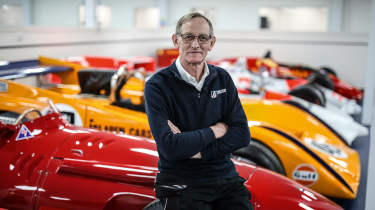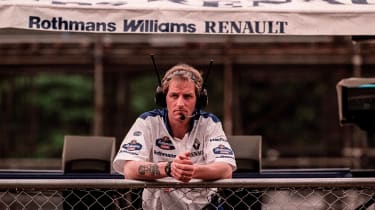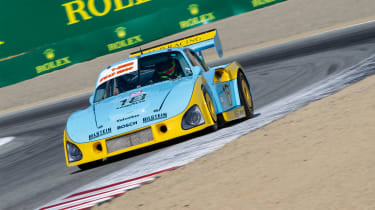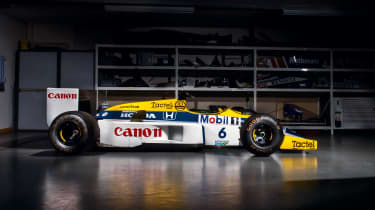My Life & Cars – Dickie Stanford, F1 race mechanic and team manager
Team manager at Williams during the team’s 1990s glory days, Dickie Stanford has had a lifelong love affair with motorsport
For a bloke who confesses to having no formal training in mechanical engineering, Richard ‘Dickie’ Stanford seems to have done all right for himself. Williams Grand Prix Engineering Formula 1 race mechanic for Nigel Mansell and then a key member of the test team. Later, chief mechanic for Williams. Then Williams team manager during the team’s golden years: he has the distinction of being the last Williams team manager to lift a Constructors’ trophy, back in 1997. He was with the team for five Drivers’ Championship titles and seven Constructors’ titles, and worked with some of the greatest names in motorsport: Frank Williams, Patrick Head and Adrian Newey; Nigel Mansell, Riccardo Patrese, Alain Prost, Ayrton Senna, Damon Hill, David Coulthard, Jacques Villeneuve, Juan Pablo Montoya, Jenson Button and Ralf Schumacher, amongst others.
After a second stint as team manager, Stanford finally stepped down from the role in 2014, having reached the conclusion that spending only 55 days in the UK during a year was probably his ‘enough’s enough’ moment. He stuck with Williams, though, taking on the position of general manager of the then newly resurrected Williams Heritage operation for superseded Grand Prix cars. And despite retiring from that job, he was persuaded to put the pipe and slippers on hold by Zak Brown, American businessman, CEO of McLaren Racing and co-owner of United Autosports, to become the latter outfit’s Historic Motorsport project manager.
> My Life & Cars – Peter Stevens, car designer
Born in Wiltshire in 1956, Stanford may not have entered motorsport with the traditional bunch of qualifications to his name, but his interest in motor racing started early. ‘A neighbour took me to a club race meeting at a little local circuit called Castle Combe when I was about 12,’ he recalls. ‘And then we went to Brands Hatch to see the 1968 Race of Champions, which Bruce McLaren won. That was my first exposure to Formula 1 and after that it was all I ever wanted to do.
‘My father was more interested in sending me into the Army or Air Force, and had no interest in motor racing whatsoever,’ Stanford continues. ‘For me, when I eventually left school I still only wanted to be involved in some sort of motor racing – I really wanted to be a racing driver. I had a chat with a chap I knew, who basically told me how expensive it was, and I came to the realisation very quickly that I wouldn’t be able to afford to be a racing driver. So the next best thing would be to work with a team.’
That wasn’t to happen immediately, however. For a couple of years after school, Stanford worked for the government – stockpiling emergency supplies of food in case of war – but then came a stroke of good fortune. ‘I met a chap called Steve Coen who ran a Formula Ford. I asked if I could help him, get involved. So I spent my weekends pushing his Formula Ford around the paddocks and then worked on it with him during the evenings.
‘Steve was a really good teacher and if you did something wrong you knew about it and didn’t do it again! Over the course of about four years he taught me about gearboxes, chassis set-up, absolutely every aspect of the car. Everything I know about mechanics is thanks to him.’
Despite learning to drive on a tractor and an old Land Rover on the family farm when he was only ten, Stanford’s brief outings in Coen’s Formula Ford during test sessions re-affirmed his belief that he wasn’t destined to be a racing driver. But he retained a long-term goal of working in F1 and knew he needed to move on to working with a team to progress down that path. Thruxton-based Scorpion Racing, owned by Mike Eastick, ran up to seven Formula Fords – and at the time prepared cars for Mike Thackwell, Jonathan Palmer and James Weaver – and provided Stanford’s first full-time job in motorsport.
After Scorpion came Tiga, which provided experience in Formula Sports 2000 sports cars and then Formula 3. When Tiga wound up its F3 activities, Stanford briefly took a ‘normal’ job, but then came a fortuitous phone call. ‘One of the guys I’d worked with at Tiga rang telling me to get my arse down to Thruxton – he was working for Ron Tauranac and the Ralt Formula 2 team and they urgently needed a hand. At the end of the race weekend Ron offered me a job.
‘So I did the last two years of Formula 2 with the Ralt Honda team and it was really the most enjoyable time I’ve spent in motor racing. It was professional but we had a lot of fun, plus we won the championship both years [1983 and 1984].’
In the lead-up to his job at Ralt, Stanford had sewn the seeds of his future employment prospects. ‘I was driving past the original Williams factory on my way home and thought I’d just stop and ask if they had any vacancies. Out of the blue I knocked on the door and Peter Collins [Williams’ team manager] gave me a two-hour interview on the spot. But they weren’t hiring anybody at the time. It was Collins who advised me to go away and get some F2 experience, which, of course, I then got with Ralt.’
And it was courtesy of Ralt that Stanford once more found himself inside Williams’ front door two years later. ‘In the winter of 1984 we started the shakedown tests of the Ralt Formula 3000 flat-bottomed car and, because it was on my way home, I was given the task of dropping off the wind tunnel model to be tested in the Williams wind tunnel. One night in December I arranged with Williams to have an interview when I dropped off the model – Peter Collins and Alan Chalice [chief mechanic] interviewed me and gave me a job there and then. I started work in January 1985 and was one of three mechanics on Nigel Mansell’s car.’
Let’s take a break at this juncture to quickly trawl through Stanford’s road car history. He confesses to not being especially excited about fast road cars these days – ‘Lamborghinis and Ferraris don’t really interest me because you can’t drive them at speed anywhere’ – and his daily driver is a Nissan X-Trail, although he does also own a SEAT Leon FR estate. Of more interest are the cars he can’t currently drive because they’re in the throes of restoration.
One is a ‘pagoda roof’ Mercedes-Benz 250 SL that’s been in his garage for about twelve and half years. ‘I really wanted a Porsche but my first wife persuaded me to buy the Mercedes. Once I’d driven it, I fell in love with it. It’s so relaxing, such a nice car to drive.’ Stanford’s other resto project is a Ford Sierra RS Cosworth, the whale-tail three-door version. ‘I bought it slightly modified with about 300bhp. I’ve had some welding done on it and it’s being painted at the moment. Once that’s done I’ll start working on the suspension and then pull out the engine.’
His very first car was a Mini that soon made way for a Ford Anglia. In turn this was replaced by a ‘family car’, a four-door Escort 1200. ‘I did then progress to a 2-litre Capri GT,’ he recalls, ‘and later on an Audi Coupe GT. A non-turbo Coupe GT quattro followed that, and then a proper Quattro, although I didn’t keep it for long.’ By 1992, Stanford was locked into company cars, Renaults and BMWs, depending on which was supplying Williams’ engines at the time.
Stanford has so many great anecdotes from his time at Williams and we have so little space here… Of the Honda engine Williams used in 1985: ‘It was still pretty unreliable and very thirsty with fuel. We’d start the race with maximum boost and then turn it down straight away, trying to get to the finish without running out of fuel.’
Computers in F1 were in their infancy in the mid-’80s, as Stanford explains. ‘It was all done with slide rules,’ he laughs. ‘We had clipboards and sat down and discussed what the car was doing: engineers would talk to the drivers and then a job sheet would be drawn up outlining changes we needed to make.’
He worked as Mansell’s mechanic until 1989, when he was persuaded to join the test team. ‘During 1990 Adrian Newey joined the team and I did a few races as well as the testing. At the end of ’90 Patrick Head asked me to become chief mechanic: I had been considering leaving to do Indy Cars and had a resignation letter in my bag when he spoke to me, so that letter never saw the light of day.
‘At the time we had the best drivers and the best cars, the money and the equipment, it was great. We had Nigel and Riccardo in ’91, in ’92 Prost and Hill, and then Senna and Hill, and then Hill and David Coulthard, and then Hill and Jacques Villeneuve. You have to say that was probably Williams’ best era, 1991 through to 1997.’
In 1994 Williams Renault won its third consecutive Constructors’ Championship and at the end of the season Stanford was promoted to team manager: ‘It was akin to being mum to 100 children. I thoroughly enjoyed the job but it was a lot of hard work. You were responsible for getting the entire team from A to B, whether it be trucks, personnel, whatever. You had to work out budgets. Attend countless meetings with the team and the FIA. And if anything went wrong regards the cars or regulations, it was down to the team manager – you’re responsible for everything.’
Family issues prompted Stanford to ask for a factory-based role in 2006, but when his kids went off to university a couple of years later, he headed back out into the field as Williams’ testing manager. Then in 2010 he was asked to reprise his role as team manager for the last six races of the season: he stayed on another four years. But at the end of the 2014 season, Stanford jumped down from the pit wall for the final time, moving on to Williams Heritage.
After all his many years at Williams, does Stanford have a favourite F1 car? ‘I have two. The FWIIB, the Honda Turbo: it was such a beast of a car with over 1000bhp and no traction control. And the FW14A, which surprises a lot of people as they imagine I’d pick the 14B, the active ride car. The 14A was my hardest year as chief mechanic because for the first half of the season it was so unreliable. But in the second half it was the fastest car on the track and we just lost out to McLaren for the World Championship.’
And what of the drivers he worked with? ‘Well, Riccardo [Patrese] was just as quick as Nigel in the 14A. And when Ralph [Schumacher] brought his A-game, he was as fast as Michael, as quick as anybody. Montoya wasn’t worried about the ruffle-puffle of F1, he just wanted to race. Nigel sometimes wasn’t the favourite driver of the garage but he could pull the whole place together – he’d come in every day and say good morning to every single person.’
Stanford’s current job, along with Paul Haigh, at United Autosports exposes him to a greater variety of cars: boss Zak Brown has a large collection of ex-competition machinery and United’s Historic Motorsports operation rebuilds and runs clients’ historic race cars, and even restores road cars. ‘It’s great that Zak wants to drive his cars: at the moment we’re running his Porsche 935, Lancia LC2 Group C, Cologne Ford Capri RS3100 and Jaguar XJR-10 IMSA car, as well as the ex-Lewis Hamilton MP4-27 McLaren and a Williams FW07B/7.’
Although now at retirement age, Stanford isn’t disposed towards giving up work, despite the inconvenience of Wakefield-based United being 200 miles from home. ‘I come up here on a Monday, go back home on a Friday. We’re looking for a house up here to see if the family like it; we’ll keep the house down south in case they don’t. Then I’d need to decide whether to keep doing the drive, or call it a day. But I have no intention of calling it a day!’
This story was first featured in evo issue 292.







